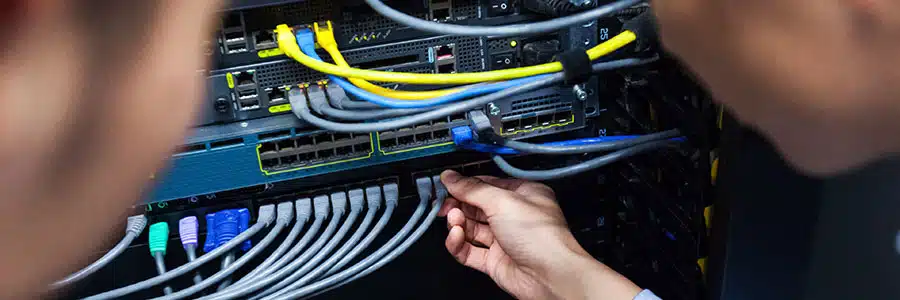
A well-designed and properly installed network cabling infrastructure is crucial to smooth and efficient business operations. It’s the backbone that connects all devices and ensures data flows smoothly throughout the organization. However, all too often, businesses make simple mistakes when it comes to network cabling that can cause big problems down the line.
Here are four common network cabling mistakes that your company should avoid.
1. Poor network cable planning and installation
If your company fails to plan the layout of your cabling infrastructure before installation, the result can be a messy and inefficient network setup. This can make it difficult to locate specific cables or equipment, leading to wasted time and effort when making changes or troubleshooting problems.
Poor planning and installation can also cause downtime and slow network speeds. When cables are installed haphazardly, they can become tangled and twisted, leading to signal interference and data loss. This can cause network slowdowns or even complete outages.
Moreover, improperly installed cables can pose safety risks; users can trip over cables or be routed too closed to power sources or other equipment. This may lead to cable or equipment damage, or even personnel injury.
To avoid such negative outcomes, make sure your cable installation abides by industry-standard practices, such as the EIA/TIA 568.
| Spectrums’s network security audit includes examining your data cabling and cable plant design |
2. Using the wrong type of cable
Different types of cables are designed for different purposes, and choosing the wrong type of cable can lead to poor network performance, interference, and even equipment damage.
For example, using a CAT5e cable instead of a CAT6 cable may seem like a minor mistake, but it can have a big impact on network performance. CAT5e cables are limited to speeds of one gigabit per second (Gbps), while CAT6 cables can support speeds of up to 10 Gbps. Using a CAT5e cable in a situation where higher speeds are needed can result in slow network speeds and data transfer rates, which can negatively impact productivity.
Another common mistake is using unshielded twisted pair (UTP) cables instead of shielded twisted pair (STP) cables in areas with high levels of electromagnetic interference (EMI), such as data centers, medical facilities with X-ray machines, and locations near power lines. UTP cables are more susceptible to EMI, which can lead to signal interference and data loss. In contrast, STP cables are designed to block EMI and can help maintain signal integrity in noisy environments.
Using the wrong type of cable can also lead to damage to equipment. For example, using a cable with too high a voltage rating can damage network devices or even start a fire. That’s why it’s important to choose cables with the correct voltage rating for your devices.
3. Lack of documentation
Many businesses fail to document their cabling infrastructure properly. This can make troubleshooting and making changes to the network difficult since you won’t know where cables are located, which devices they are connected to, and how they are configured.
Having thorough and up-to-date documentation of your network cabling can help you save time and money when troubleshooting or making changes to the network. It also ensures that new hires or any IT personnel can understand the existing network setup and quickly identify potential problems.
4. Failing to future-proof the cabling infrastructure
Over time, technology will become more advanced, and you will need to upgrade your network to keep up with the latest technologies. This means that you should plan for upgrades in advance by ensuring that your cables are not too short or that you have enough ports to support future changes to the network.
You don’t have to worry about making these four mistakes when you partner with SpectrumWise. With us at your side, you can be sure that your company will always have a reliable, efficient, and safe cabling infrastructure. Schedule a FREE consultation with us today.



